Tomb of Cyrus
The Tomb of Cyrus (Persian: آرامگاه کوروش بزرگ translit. ārāmgāh-e kurosh-e bozorg) is the monument of Cyrus the Great approximately 1 km southwest of the palaces of Pasargadae. According to Greek sources, it dates back to 559–529 BC. The most extensive description based on a lost account by Aristobulus, who had accompanied Alexander the Great on his eastern campaign in the late 4th century BC, is to be found in the Anabasis of Arrian (6.29). written in the 2nd century AD.[1]
| Tomb of Cyrus The Great آرامگاه کوروش بزرگ (in Persian) | |
|---|---|
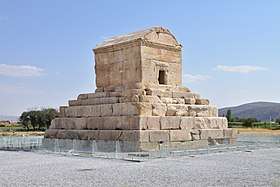 Tomb of Cyrus the Great. | |
| Location | Pasargadae, Iran |
| Built | 6th century BC |
| Architectural style(s) | Persian architecture Achaemenid architecture |
 Location Pasargadae Iran. | |
History
When Alexander the Great looted and destroyed Persepolis, he paid a visit to the tomb of Cyrus. Arrian, writing in the second century AD, recorded that Alexander commanded Aristobulus, one of his warriors, to enter the monument. Inside he found a golden bed, a table set with drinking vessels, a gold coffin, some ornaments studded with precious stones and an inscription on the tomb. No trace of any such inscription survives, and there is considerable disagreement to the exact wording of the text. Strabo reports that it read:
Passer-by, I am Cyrus, who founded the Persian Empire, and was king of Asia.
Grudge me not therefore this monument.
Another variation, as documented in Persia: The Immortal Kingdom, is:
O man, whoever thou art, from wheresoever thou comest, for I know you shall come, I am Cyrus, who founded the Persian Empire.
Grudge me not, therefore, this little earth that covers my body.

The design of Cyrus' tomb is credited to Mesopotamian or Elamite ziggurats, but the cella is usually attributed to Urartu tombs of an earlier period.[2] In particular, the tomb at Pasargadae has almost exactly the same dimensions as the tomb of Alyattes, father of the Lydian King Croesus; however, some have refused the claim (according to Herodotus, Croesus was spared by Cyrus during the conquest of Lydia, and became a member of Cyrus' court). The main decoration on the tomb is a rosette design over the door within the gable.[3] In general, the art and architecture found at Pasargadae exemplified the Persian synthesis of various traditions, drawing on precedents from Elam, Babylon, Assyria, and ancient Egypt, with the addition of some Anatolian influences.
According to the records by the ancient Greek historian, Aristobulus: "The tomb - in the lower parts was built of stones cut square and was rectangular in form. Above, there was a stone chamber with a roof and a door leading into it so narrow that it was hard and caused much distress for a single man of low stature to get through. In the chamber lay a golden sarcophagus, in which Cyrus' body had been buried; a couch stood by its side with feet of wrought gold; a Babylonian tapestry served as a cover and purple rugs as a carpet. There was placed on it a sleeved mantle and other garments of Babylonian workmanship . . . Median trousers and robes dyed blue lay there: some dark, some of other varying shades, with necklaces, scimitars, and earrings of stones set in gold, and a table stood there. It was between the table and the couch that the sarcophagus containing Cyrus' body was placed. Within the enclosure and by the ascent to the tomb itself there was a small building put up for the Magians who used to guard Cyrus’ tomb.”
The Mausoleum is said to be the oldest base-isolated structure in the world, meaning it is resilient to seismic hazards.[4] It is one of the key cultural heritage destinations in Iran.[5]
Cyrus the Great Day

Cyrus the Great Day (Persian: روز کوروش بزرگ ruz-e kuroš-e bozorg), also simply known as Cyrus Day (Persian:روز کوروش ruz-e kuroš), is an unofficial holiday in Iran that takes place annually in the tomb of Cyrus on October 29th, 7th of Aban on Iranian calendar, to commemorate Cyrus the Great. That is the anniversary of the entrance of Cyrus into Babylon. Cyrus is founder of the first Persian Empire also known as Achaemenid Empire.[6]

Iranian New Year
During Nowruz, the Persian New Year, celebrations are held annually around the tomb by Iranians which gather from all around the country. Iranians respect Cyrus the Great as the founder of Iran and the Persian Empire.[7][8]
Gallery
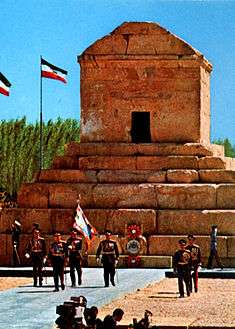
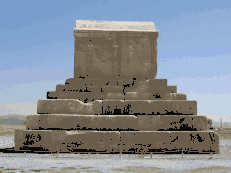 Circling animation around the mausoleum.
Circling animation around the mausoleum.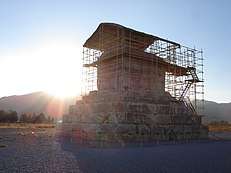 Tomb of Cyrus under repair.
Tomb of Cyrus under repair.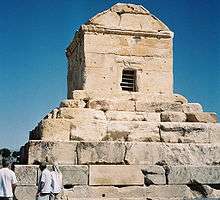 Mausoleum of Cyrus the Great in Iran.
Mausoleum of Cyrus the Great in Iran.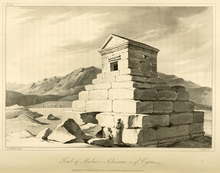 By Robert Ker Porter, 1818
By Robert Ker Porter, 1818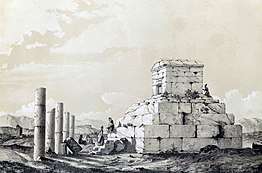 Passargade by Eugène Flandin, 1840
Passargade by Eugène Flandin, 1840_p621_TOMB_OF_CYRUS%2C_MURGHAB.jpg) John Ussher, 1865
John Ussher, 1865 Gur-e-Dokhtar, possible tomb of Cyrus I
Gur-e-Dokhtar, possible tomb of Cyrus I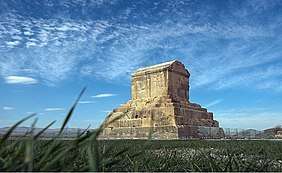 Tomb of Cyrus the Great
Tomb of Cyrus the Great
See also
Notes
- Tomb of Cyrus the Great. Old Persian (Aryan) - (The Circle of Ancient Iranian Studies - CAIS)
- Hogan, C Michael (Jan 19, 2008), "Tomb of Cyrus", in Burnham, A (ed.), The Megalithic Portal
- Ferrier, Ronald W (1989), The Arts of Persia, Yale University Press, ISBN 978-0-300-03987-0
- Masoumi, Mohammad Mehdi (2016-03-31). "Ancient Base Isolation System in Mausoleum of Cyrus the Great". International Journal of Earthquake Engineering and Hazard Mitigation (IREHM). 4 (1). doi:10.15866/irehm.v4i1.8147 (inactive 2020-01-22). ISSN 2282-6912.
- Butler, Richard; O'Gorman, Kevin D.; Prentice, Richard (2012-07-01). "Destination Appraisal for European Cultural Tourism to Iran". International Journal of Tourism Research. 14 (4): 323–338. doi:10.1002/jtr.862. ISSN 1522-1970.
- "منشور کورش بزرگ". Savepasargad.com. Retrieved 2011-10-15.
- "Visitor anti-robot validation". Fouman.com. Retrieved 2017-01-11.
- "Iran: The Challenges of a Split Personality - ASHARQ AL-AWSAT English". English.aawsat.com. Retrieved 2017-01-11.
References
- R.M.Ghias Abadi (2004) Achaemenid Inscriptions, 2nd edition, publisher Shiraz Navid ISBN 964-358-015-6
- Amelie Kuhrt (1995) The Ancient Near East: ca. 3000-330 BC, chapter 13, p. 647, Routledge ISBN 0-415-16762-0
- Arrian, Anabasis I. IX; cf. M. A. Dandamaev Cyrus II, within Encyclopaedia Iranica
| Wikimedia Commons has media related to Tomb of Cyrus the Great. |


